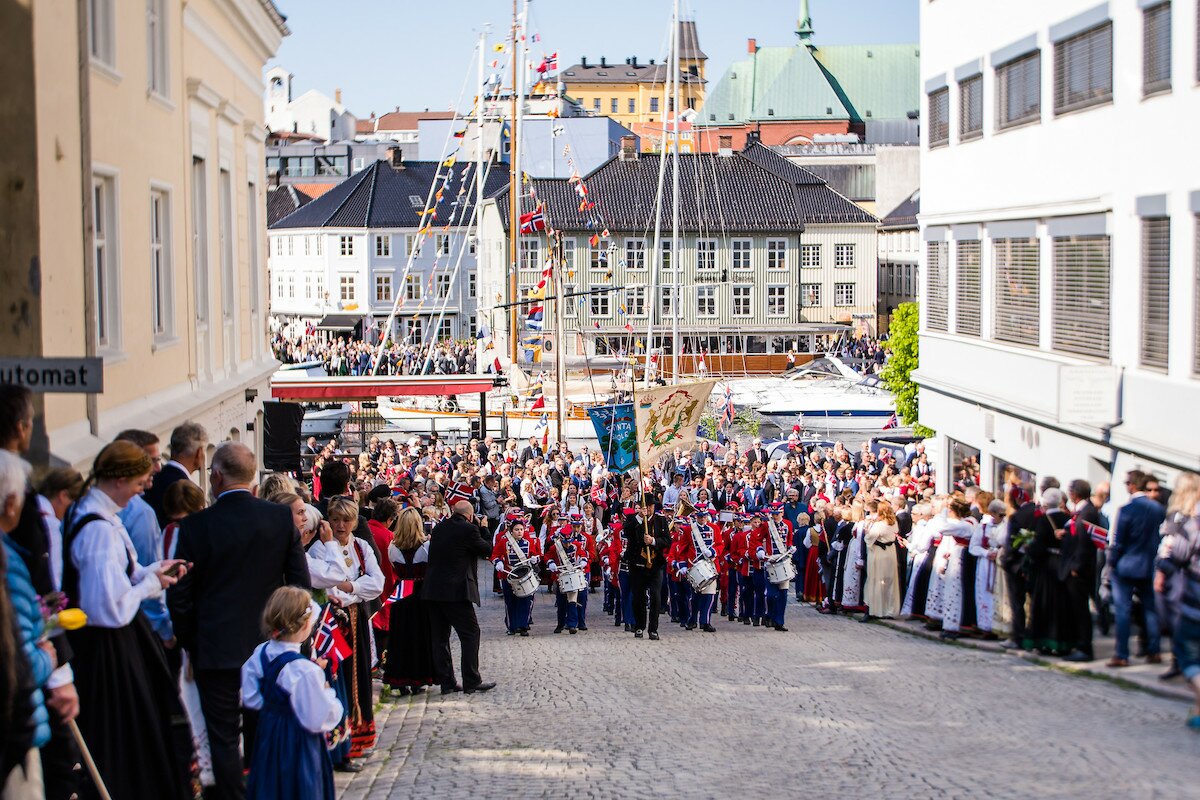This May 17 was the first Norwegian national day, since 2019, that the country celebrated openly and freely without any pandemic-related restrictions, lockdowns, or (thankfully) masks! From the famous “barnetoget” to the overconsumption of ice cream (and alcohol!) what were some of the highlights of the nation’s celebrations undertaken for the first time in more than two years?
Norway re-emerges from its first post-COVID national celebration
This year’s national day (17 Mai or Grunnlovsdagen) was always going to be special. For the first time in 3 years, a normal national celebration took place. Gone were facemasks, hand sanitizer, social distancing, barnetoget on Minecraft, or any other limited and limiting COVID-era celebrations. They were replaced by the largest barnetoget ever in the nation’s capital and a freedom and joy not seen on Norway’s national day since 2019.
So how did the different parts of Norway celebrate Syttende Mai (May 17)? What is for sure is that the nation partied, celebrated, and undertook festivities with a freedom not since in more than 3 years.
Oslo – history, tradition, and a pair of space wolves kicking off festivities
The nation’s capital is often the focal point of activities for the 17 Mai celebrations. The more somber aspect of the day, away from the champagne breakfasts and ice cream consumption, is a series of thanksgiving events held around the city. Speeches and wreath-laying ceremonies were given at the graves of Norwegian cultural giants: Henrik Ibsen, Henrik Wergeland, and Bjørnstjerne Bjørnson. Wergeland’s remembrance on this day was especially poignant as he is credited with essentially shaping and creating modern Norwegian heritage and culture. The focus then shifted to Akershus Fortress where there was a wreath-laying ceremony at the Memorial to Norwegian Patriots (who died during the Nazi occupation of the country in the Second World War) located in Akershus Fortress.
The main event of Oslo’s festivities, however, is the famous barnetoget (Children’s parade). For the first time since 2019, the barnetoget took to the streets of downtown Oslo in what was the largest parade since its inception in 1870. More than an estimated 60,000 children, from 130 local schools, paraded up to the Slottet (Royal Palace) to be greeted by members of the Royal Household. What gave this historical tradition a contemporary twist is that the beginning of the parade saw Norway’s recent Eurovision entry, Subwoolfer, perform with the Kampen Janissary Orchestra and 60 children from West End Dance and Music School.
Bergen – a strong maritime and student theme for festivities
The nation’s second city also saw a jam-packed day full of activities, parades, and festivities. Following the traditional gun salute from Skansen, a morning procession – full of Russ students and music corps – wound its way through the streets of Bergen ending up at the main town square, Festplassen. A wreath was laid at the statute of Bergen Museum’s founder, President of the Storting, and Eidsvollmann Wilhelm Frimann Koren Christie with a speech by the leader of the Student Society in Bergen. A memorial service for those lost in war was held at Nonneseter Memorial Hall whilst across the city at the Cathedral a festive service was held in Nynorsk. As Bergen is a major student city the streets were once again filled with younger people enjoying themselves (some perhaps too much!), especially in the afternoon and evening.
One of the highlights of Bergen’s festivities, however, took place on the water. The annual 17 Mai boat parade saw local Bergenser take to the open waters in a variety of small and large boats and ships. At the same time, the Flaggtoget (flag parade) saw hundreds of Norwegian flags being marched through the city. Following the main procession, skydiving took place over Lille Lungegårdsvann whilst the Bergen Music Pavilion saw two concerts by the Tveiterås School Choir and the Dragefjellet’s Music Corps. Following folk music, dancing, and general merrymaking in both Festplassen and Torgallmenningen the day ended with a torchlight procession and fireworks.
Stavanger – special anniversary celebrations for many of its cultural institutions
Further down the west coast of Norway, Stavanger’s celebrations involved three different parades marching through the city. The first was the barnetoget which saw over 55 education organizations and schools take place. Following this, many children flocked back to the city’s primary schools which were open to the public offering food, music, and games. A church service – to give thanks and to remember those Norwegian patriots who have died for this country – was given at St. Petri church whilst the Russ students took over the streets with their own parade from early afternoon.
The last main event of the day was the Folketoget (People’s Parade). The theme, this year, was a celebration of the cultural and social diversity of the city itself and the nation at large. There were some special anniversaries for organizations and institutions that took place in the parade, with Stavanger Roller Derby Club, Stavanger Karate Club, Rogaland Theatre, and Storhaug School Corps celebrating their 10th, 50th, 75th, and 110th anniversaries respectively.

Trondheim – a city full of musical celebrations
Trondheim saw its Syttende Mai celebrations take on a very musical theme. Whilst the barnetoget took place relatively early, this freed up the whole day for a series of musical concerts dotted throughout Norway’s former capital. Some of the more poignant concerts were held at St. Olav’s hospital – where a brass band performed at the Women’s and Children’s center – and at the Ranheim Health and Welfare Association.
The beautiful and gothic Nidaros Cathedral was a center point of religious festivities as there was a service of thanksgiving and celebration conducted by Bishop Ragnhild Jepsen and the Nidaros Choir. This was followed later in the day by a party concert and service held in Our Lady’s Church with the Central Norwegian Symphony Orchestra performing.
Best of the rest around Norway and the world
Away from the bigger cities, celebrations were nonetheless just as frantic, fun, and festive. Lofoten organized a free movie screening for the locals following the parades. The Øren Skolekorps performed a series of concerts at residential and care homes in Drammen whilst a party for older citizens was organized in the center of Bodø. There was a huge fireworks display over Odderøya in Kristiansand whilst a festive cafe was organized for citizens with disabilities with music from the Skittenelv Music Corps up in Tromsø.
Norwegians overseas also marked the day with celebrations and parades. There was the annual May 17 Parade in Brooklyn, New York whilst it was the 40th anniversary of the annual May 17 banquet in Minneapolis, Minnesota – a region of the United States famous for its Norwegian ancestry. A boat party and parade were held in Sydney Harbour while the Norwegian Ambassador to Thailand opened the residence doors in Bangkok for Norwegians to hold festivities and even a barnetoget. The Norwegian School also organized a barnetoget in Gran Canaria, Spain. Finally, hundreds of Norwegians took over Southwark Park in south London to celebrate as well as listen to a speech by the current Minister of Finance, Trygve Slagsvold Vedum.
Source : #Norway Today / #NorwayTodayTravel
Do you have a news tip for Norway Today? We want to hear it. Get in touch at [email protected]





Be the first to comment on "May 17 “Unrestricted”: How did Norway celebrate its first national day post-COVID?"